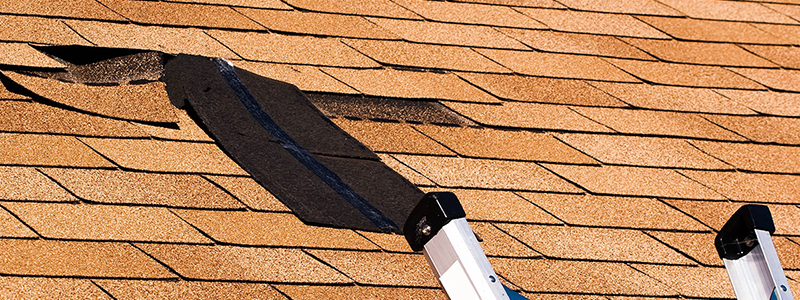
Wind Damage To Roof
If you’re a homeowner or owner of a commercial building, you probably realize that your roof is one of the most valuable aspects of your property, and maintaining it is critical. You’re also aware that if your roof becomes damaged, it can be urgent to fix before more problems spread through the rest of the structure.
But if you aren’t a roofing expert, how do you know what is considered wind damage to roof?
Obvious weather elements that cause destruction, such as rain or hail, are just the start of a homeowner’s roofing concerns.
A widely ignored type of damage from storms is wind damage.
Strong, violent winds create stress points on a roof that eventually become compromised. The good news is that immediately replacing damaged roofing systems will save your home from water damage, and save you the costs of much more expensive repairs.
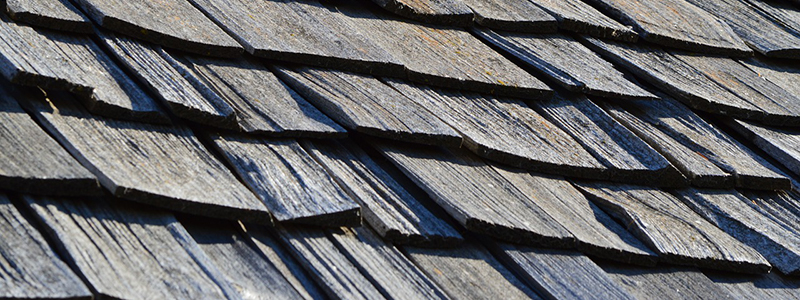
How Wind Damages Your Roof
Strong winds can move in many directions in a storm, catching corners and perimeters of your roof. Anywhere the roofing material is even a little loose, the wind gets below and pries it up. The next time a storm strikes, the lifted materials have surface area for the wind to catch onto. It’s a self-reinforcing reaction once the wind starts damaging shingles, with each successive storm further damaging your home. Once shingles are damaged, you risk water damage, so you can’t afford to ignore these signs of wind damage to a roof.
Signs of Wind Damage to a Roof
Wind-damaged roof appearance varies by the type, but mainly focuses on a few main areas:
- Shingle Damage
- Wood Shingles/Shakes Decay
- Flat Roof
- Flashing
- Roofing cement
Shingle Damage
Missing shingles are one of the easiest to determine signs of storm damage to the roof. But even if they aren’t missing, be on the lookout for any noticeable damage. If they look too smooth, that is an indication that they have suffered some loss of granulation. Also, watch for any curling or bowing indicating something is structurally wrong with the shingle. Obviously, cracks or breaks are big red flags.
A good general rule is that if your shingles don’t look smooth and uniform, there is a high likelihood they are damaged and could lead to worse problems if not repaired immediately.
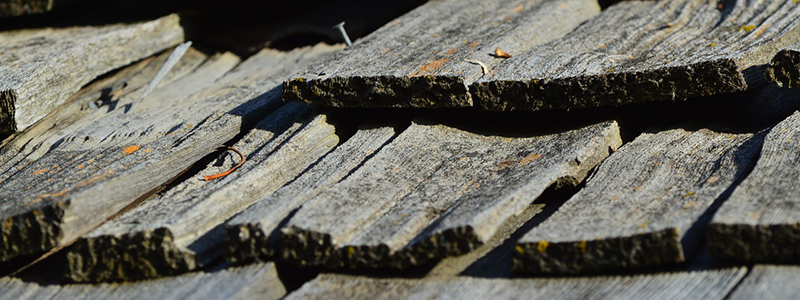
Wood Shingles/Shakes
Wood shingles and shakes are made, not surprisingly, from wood. While wood makes a great building material, it can be vulnerable to mold and decay. While there are different roof coatings that can help prevent this, be on the lookout for anything in the wood that looks warped, discolored, split, or otherwise unusual.
Flat Roof
Flat roofing may seem like it’s less likely to be damaged by wind, but it can still see significant damage. Identifying it is slightly different since it doesn’t typically use shingles. Instead, keep an eye out for any blistering or wrinkling that you see. This is typically a sign of wind uplift, which is when the air manages to get under the material and cause wind damage to a flat roof.
Also, look out for any cracks or tears that could cause leaks and other problems.
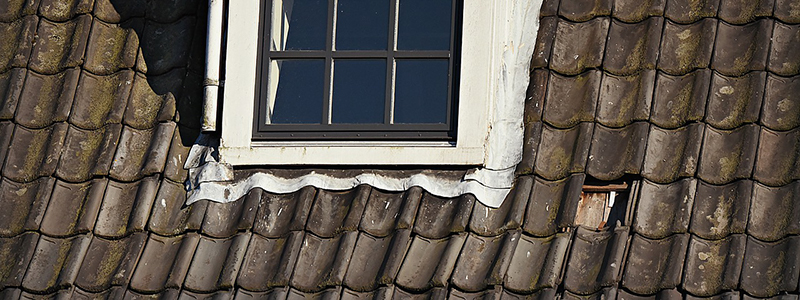
Damaged Flashing
Flashing is the metal material that is generally placed where the shingles meet a flat surface, such as at the start of the chimney. The primary point of this is to prevent water from getting under the shingles. But it is typically made out of flat, thin metal, so it can be particularly vulnerable to wind.
Tears or buckling in the flashing is one of the signs of wind damage to a roof that you shouldn’t ignore.
Crumbling Roofing Cement
Roofing cement is a solution that is often used to repair damaged sections of a roof. Pay particularly close attention to this if it’s on your roof, because if it seems to be crumbling, that is a big example of wind damage and it needs to be repaired or replaced.
How to Detect Wind Damage to Roof
After a storm, you can check for shingles on the ground and search your roof for missing shingles or other types of damage. High winds can damage shingles and tear them off altogether. It is also important to look for other warnings of aging, such as warping.
If it looks like the shingles are starting to curl or you start to see small holes, your roof is damaged and you are at risk for more damage in storms and freezes.
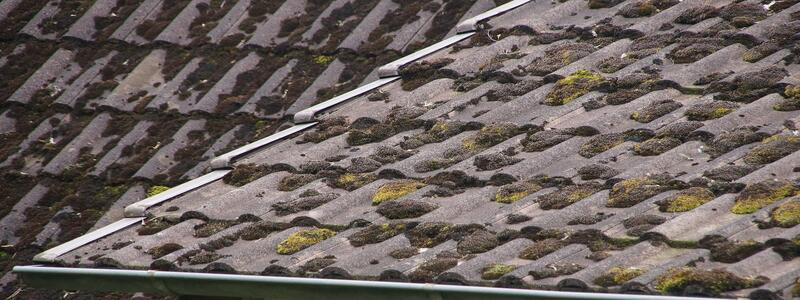
Perform an Outdoor Inspection
Check for missing and damaged shingles on your roof and around your home. While you are checking your roof, inspect the:
- Chimney
- Ventilation pipes
- Roof flashing
- Gutters
- Fencing
Please note that these are elements that can suffer great damage after strong winds and damaging storms.
Perform an Indoor Inspection
Moisture marks, brown, yellow, or grey stains, and peeling paint on walls and/or ceilings all indicate a damaged, leaking roof as well as damp rafters or leaks in your attic. If there is a sudden increase in energy costs, this could be a sign your roofing ventilation has been compromised.

Will Insurance Cover Wind Damage to a Roof?
One of the first questions we typically hear in these situations is “will insurance cover wind damage to a roof?” The good news is that the answer is often yes!
Of course, it depends on the amount and type of damage, as well as the details of your insurance policy. But since this is a very common type of damage and it can lead to so many other problems, insurance companies tend to be more flexible about it.
We recommend contacting your agent to learn more about the wind damage to roof insurance claim details under your specific policy.
Insurance Coverage for Wind Damage to Roofs
Most wind damage caused by storms is usually included in homeowners’ insurance coverage. Depending on the type of coverage your insurance provides, it usually covers various types of damage caused by natural disasters. Policies usually protect you from damage caused by:
-
- Snowstorms
- Hail storms
- Tornadoes
- Hurricanes
Among some kinds of storms and weather events.
This windy April is breaking records in Colorado
This April Colorado has experienced record strong winds and more dry & windy days are expected by the end of the season. Mostly it is due to a pattern of storm systems north of Colorado, which is causing so many dry and windy days. This type of wind originated at the bottom of this storm pattern. This means that most of the moisture has been directed over the Front Range.
This was The Windiest April in Denver Since 1980
Data from DIA and Centennial Airport indicate that this April was the windiest in Denver in the last 30 years.
This April in Denver winds reached statistical records, making it the windiest April since the 1980s. This was caused by a stagnant storm pattern that was creating continuous waves of strong winds.
Since the first few days of April, winds have been recorded with an average speed of 13 mph, being this more than 2mph above the usual average within this period. At Centennials Airport, the average wind speed is 11.1 mph, making it the highest recorded since 1989.
April is on average the windiest month of the year in Denver and most of Colorado, however this year, the stagnant storm pattern has pushed these storms northward, causing Denver and much of Colorado to experience much drier and windier weather. This is a typical patter on April, but this year have brought more concern than usual.
Although this high wind season is almost over, it is never too late to inspect your roof, as it may have suffered damage, which is always best to repair as soon as possible to avoid further problems in the future.
Protecting your Property from Wind Damage in Advance
It is always good to anticipate the damage that high winds can cause, especially at this time of year when high winds can cause extensive damage to your property, especially to your roof. Here we share with you some tips to take in count to avoid some of the big damages that this extreme wheathers can cause:
- Use lighter landscaping materials.
- Keep trees trimmed away from the roof.
- Have your roof inspected by a professional as soon as possible (especially if you think there are wind-damaged shingles or other troubles)
Get Professional Help with Signs of Storm Damage to Roof
If you notice signs of wind damage to roof, call B&M Roofing at 303.443.5843. We provide roofing service and repair on everything from small residential roofs to complicated high-end commercial properties throughout Colorado and its surrounding areas. For more information, visit Quality Roofing Service and Repair for a complete list of services B&M Roofing provides.




































